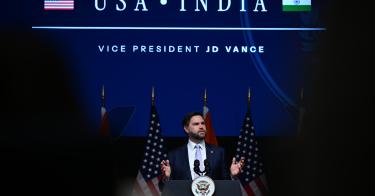Tensions between India and Pakistan are high again, this time following a terrorist attack in Jammu and Kashmir in late April that killed 26 tourists—25 Indian and one Nepali.
In early May, India launched targeted strikes on nine terrorist camps in Pakistan, both in Pakistan-occupied Kashmir and in Pakistan’s Punjab province. Pakistan retaliated, and the two sides exchanged volleys of missiles, drones, and artillery. These attacks continued until a ceasefire was announced on May 10.
Border skirmishes and line of control violations in this sector are tragically familiar, but this episode yet again underscores the persistent threat posed by terrorism in South Asia. And it raises complex questions for the United States as it works to deepen its strategic partnership with India.
Pakistan’s Long Shadow on Counterterrorism
Pakistan has long been a hub for regional terrorist groups. Indeed, the discovery of Osama bin Laden in Abbottabad in 2011 raised very real concerns about Pakistan’s longstanding and ongoing links to various terrorist outfits.
>>> Terror Attack Could Mean a Pakistan-India War Is Coming
Groups such as Lashkar-e-Taiba (LeT) and Jaish-e-Mohammed (JeM) have launched deadly acts of terrorism like the 2008 Mumbai attacks and the 2019 Pulwama bombing. Yet despite their actions, they continue to operate openly and freely within the country.
Indeed, one of the terrorists killed in India’s recent response was Abdul Rauf Asghar, a top JeM commander implicated in the brutal 2002 killing of American journalist Daniel Pearl. At a funeral following India’s strikes, Pakistani military officers were filmed mourning the dead alongside a notorious U.S.-designated global terrorist from LeT. Pakistan could not claim plausible deniability.
On May 13, Prime Minister Narendra Modi claimed that India’s cross-border operations had eliminated over 100 terrorists and destroyed multiple active terrorist camps. The Indian director general of military operations briefed reporters with satellite imagery and intercepts showing the locations of camps taken down, underscoring the precision of India’s response.
What Washington Has Learned
Under the first Trump administration, U.S. policy toward Pakistan underwent a significant change. In 2018, the administration suspended most civilian and military aid to Pakistan, with President Trump accusing Pakistan of "deceit" and of harboring terrorists.
At the time, President Trump tweeted that the United States has "given Pakistan more than 33 billion dollars in aid over the last 15 years, and they have given us nothing but lies & deceit, thinking of our leaders as fools. They give safe haven to the terrorists we hunt in Afghanistan, with little help. No more!"
The move marked a clear departure from earlier attempts to partner with Pakistan on regional counterterrorism efforts.
The second Trump administration has continued this principle. In February, President Trump suspended over 39 programs in Pakistan and cut over $800 million in aid—although, regretfully, the administration did approve $397 million for regular maintenance of Pakistan’s F-16 fleet in February 2025.
Counterterrorism Is Now an Indo-Pacific Question
As the U.S. expands cooperation with India through initiatives like INDUS X, INDUS Innovation, and TRUST, it’s important to maintain clarity on basic security concerns. India’s ability to defend itself against attacks from weaker opponents isn’t only a matter of regional stability—it’s central to building trust and enabling different militaries to work together in the Indo-Pacific and to developing joint efforts to combat various challenges from China.
However, the landscape is further complicated by Pakistan’s deepening defense relationship with China—including its reported use of Chinese-origin drones, missiles, and air defense systems in its recent military operations against India. These dynamics blur the lines between regional terrorism and great power rivalry, and they underscore why the United States and India can no longer afford to treat South Asian terrorism as disconnected from its broader Indo-Pacific strategy.
Traditionally, the Quad grouping (Australia, India, Japan, and the United States) has focused on maritime cooperation, but recent ministerial dialogues have included discussions on counterterrorism cooperation, intelligence sharing, and emerging threats. The recent unrest should serve as an impetus to start investing in making counter-terrorism a more central part of the Quad’s portfolio.
India’s Growing Reliance on the West
The recent unrest also underscores India’s dependence on the West for its military strength. While the Russian-origin S-400 air defense system drew media attention, most of the critical platforms used in India’s Operation Sindoor were either indigenous or Western in origin. The operation prominently featured French-made Rafale fighter jets, which were equipped with SCALP and HAMMER precision-guided missiles.
India also employed SkyStriker and Harop loitering munitions, developed in collaboration with Israel, to neutralize mobile and radar-protected targets. To assess damage and confirm the success of the strikes, India used high-resolution satellite imagery from Maxar Technologies, a U.S.-based firm.
>>> Why U.S. Tariffs Can Be an Unlikely Opportunity for India
The integrated use of these platforms points to India’s growing defense interoperability with key Western partners—an interoperability that continues even as it builds out its indigenous capabilities.
A Fragile Calm
The current ceasefire offers temporary respite but not a resolution. Terrorism emanating from Pakistan’s soil remains a persistent threat—one that has repeatedly disrupted regional stability and now increasingly intersects with broader geopolitical challenges, including China’s growing defense ties with Islamabad.
This moment demands growing coordination. The fight against terrorism in South Asia is not India’s burden alone—it is a shared imperative for the United States, its partners, and the broader international community. If Washington and New Delhi are serious about building a resilient Indo-Pacific, they must also be serious about confronting the transnational terror networks that undermine it.
Otherwise, the region will be left without peace and security—and the promise of innovation, co-development, and strategic trust will remain out of reach.
This piece originally appeared in RealClear World




